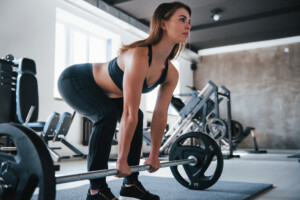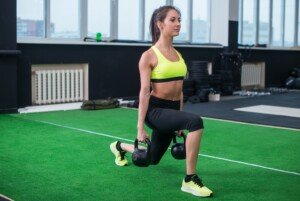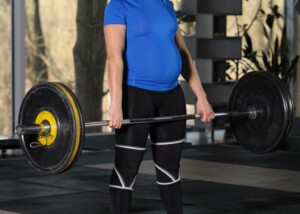Don’t think for a second that the lifting you do on the job as a nurse replaces a structured strength training regimen.
In fact, you need to strength train more than ever because of all the lifting of patients you do on the job.
Depending on the workplace environment, some nurses must routinely lift, hoist, transfer, maneuver and move adult patients.
Some patients are very heavy, but even a slender patient could be difficult to maneuver due to “dead weight” and the unequal distribution of weight that comes with the human body.
An exhausted or aching nurse may feel that a conventional strength training program is a joke because of all the lifting they do in their profession.
But if you do plenty of lifting on the job, this is all the more reason to adhere to a strength training routine that employs free weights and machines.
Ways that Lifting As a Nurse Is Different from Lifting at a Gym
The element of control. At a gym (or with home workout equipment), you get to decide the amount of resistance.
Typically, you’ll choose a weight load with which you can perform several repetitions with good form.
A popular range is between eight and 12 reps. This means that the load likely won’t be heavy enough to make your body buckle or threaten serious injury.

The deadlift. Works the back, legs, arms and core. Freepik.com
But on the job, you don’t choose the weight of your patients. If you’re tasked at transferring a 270 pound patient from the bed to a standard chair, or from the toilet to a wheelchair, this is what you must do.
Unlike with a gym, you don’t have options at the workplace that can accommodate your strength abilities.
Nor can you choose the type of movement. It might be “back day” every day on the job.
A gym or home exercise equipment offers structure, organization and systemizing, plus the very important neutral spinal alignment. You can also take rests when you need to.
Traditional workouts provide time and space. On the job, you may not be able to take your time while lifting a patient. Other patients are waiting for your care.
At a gym, you can take all the time you want to prepare for a “big lift.”
You can also arrange for optimal space – something you may not be able to do on the job such as with the confines of a bathroom.
Though patient room bathrooms are usually quite roomy, what if the patient suddenly has to go, and the nearest bathroom is small?
This happened to me once while my father was waiting for his appointment at a medical clinic.
Though I’m not a nurse, I was his caregiver, and that bathroom was far from roomy, believe me.
But thanks to my strength training regime, I had no problem helping him down and up from the toilet.
Weight distribution. Barbells, dumbbells, kettlebells and heavy balls come with an even weight distribution. Human bodies don’t.

Plus, barbells and dumbbells are made to be easily and efficiently gripped and held onto.
All this is why it’s a lot easier to deadlift a 225 barbell for reps than it is to lift a dead-weight 225 pound patient from the floor and onto a bed.
The even distribution of exercise equipment allows you to employ good, effective form. But form gets lost when maneuvering a person, particularly a morbidly obese one.
Because a patient’s body isn’t a fixed object like a barbell, it’s much easier to suffer an injury moving it around.
Nurses sometimes recruit each other to help with lifts. But two nurses lifting a 200 pound, “dead weight” patient simply cannot be compared to those same two nurses standing on either end of a 200 pound barbell and, with proper biomechanics, lifting it off the floor.
The resistance is equally distributed for each nurse with that barbell, but not so with a same-weight patient whose body is limp and floppy.
In short, “good form” doesn’t translate to much when lifting and moving people, but is quite applicable with barbells and other free weights.
Plus, machines have good form built into them, though it’s possible to utilize poor form on a machine.
“If you are repeatedly lifting patients, then you want to make sure that your body is capable of doing that by training all of the muscle groups involved so that you’re not predisposed to injury,” says Dr. Megan McLain, PT, DPT, cofounder of Intuitive Choice Physical Therapy & Wellness in Atlanta, GA.
“It is wise to work smarter and not harder. Meaning, you don’t want to just try to muscle through lifting a patient.
“You want to perform lifting in a team of people and utilize equipment, and leverage your body weight to be able to move someone.
“Beyond that, training the muscles around the scapula, the core, and performing squats should be a standard part of a well-rounded strength training program for nurses, because they have to use those muscle groups repetitively daily.
“This has a lot more to do with body mechanics than strictly strength.
“You always want to use proper mechanics and use your whole body vs. just pulling with your back or arms.
“You always want to bring a patient’s body as close to you as you can to utilize shorter lever arms and limit the risk of straining your muscles.”
The farther a weight is away from the body, the more strain there will be on the lower back.
Imagine picking up a heavy crate of books from the floor while keeping your arms nearly straight out.
Now imagine picking up that crate with your arms as bent as possible close to your body; it’s easier this way and less stressful to the low back.
Lifting on the Job Requires Lifting in the Gym
So if you’re a nurse (or CNA), this is all the more reason you should include a resistance workout program in your life.

Walking weighted lunge. Works the legs, arms and core. Shutterstock/Undrey
I once knew a CNA who competed in Special Olympics powerlifting. I bet she had few problems on the job when it came to moving people.
A strength training program will seriously reduce your risk of injuries from workplace tasks.
Exercises such as the deadlift, kettlebell swing, squat variations, the standing overhead press, weighted lunge and bent-over barbell row will sturdy-up your core, significantly strengthen your entire back and legs, strengthen your arms and shoulders, and make you more efficient at lifting on the job.

Standing overhead press. Works the shoulders, triceps and core. Depositphotos.com
Just two days a week for 45 minutes in the gym will make a big difference and help reset your body for the next time you’re performing duties as a nurse.
 Dr. Megan McLain, PT, DPT, puts her clients first while providing one-on-one in-home care. With physical therapy and health coaching services, Dr. McLain addresses all aspects such as physical barriers, mindset, accountability and knowledge that may be impacting the client’s experience.
Dr. Megan McLain, PT, DPT, puts her clients first while providing one-on-one in-home care. With physical therapy and health coaching services, Dr. McLain addresses all aspects such as physical barriers, mindset, accountability and knowledge that may be impacting the client’s experience.
 Lorra Garrick is a former personal trainer certified by the American Council on Exercise. At Bally Total Fitness she trained clients of all ages for fat loss, muscle building, fitness and improved health.
Lorra Garrick is a former personal trainer certified by the American Council on Exercise. At Bally Total Fitness she trained clients of all ages for fat loss, muscle building, fitness and improved health.
.


























